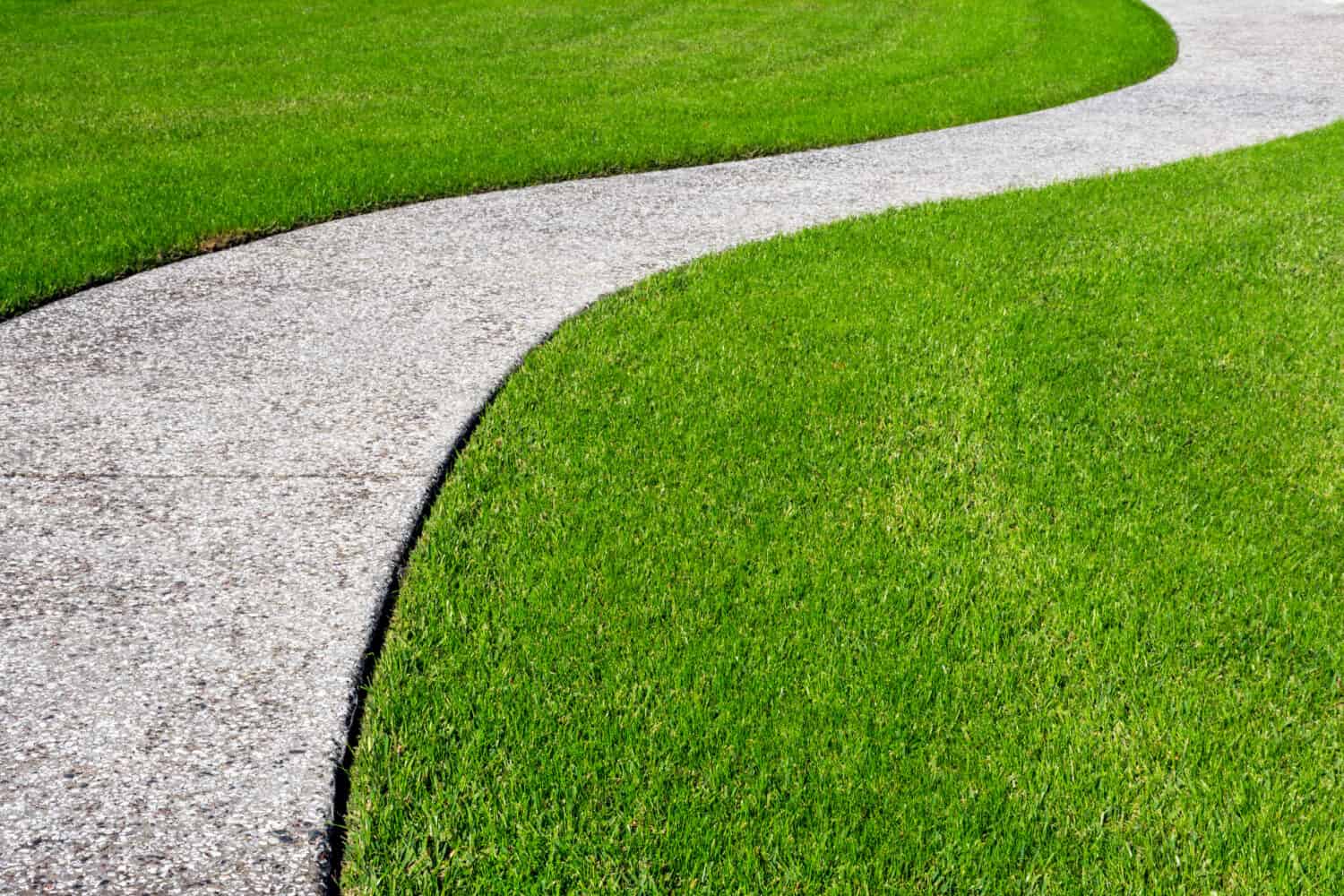Cultivating a healthy, vibrant zoysia grass lawn is a dream for many homeowners. However, the reality of dealing with dying zoysia grass is disheartening. Discover ten reasons your zoysia grass keeps dying. Whether it is issues with watering, soil quality, pests, or other culprits, understanding these reasons is the first step towards revitalizing your once lush grass carpet.
1. Improper Watering
Zoysia grass is a warm-season turfgrass known for its unique characteristics and adaptability. It is drought- and heat-tolerant and has the highest shade tolerance of warm-season grass types. Unfortunately, improper watering is one of the leading causes behind a struggling zoysia grass lawn.
Both overwatering and underwatering wreak havoc on your grass’ health, and understanding the signs and implementing proper watering techniques is the key to reviving your lush, green oasis.

Zoysia grass requires 1 to 1.5 inches of water weekly.
©iStock.com/MaYcaL
Signs of Overwatering
Overwatering is a well-intentioned mistake that many homeowners make in their quest to maintain their green lawns. While watering is crucial for your yard’s health, excessive moisture can lead to a host of problems. Recognizing the signs of overwatering is the first step towards ensuring the vitality and longevity of your turfgrass.
- Yellowing grass: Excessive moisture can lead to yellowing or browning of your grass blades.
- Fungus: Moist grass creates a favorable environment for fungal diseases like brown patches.
- Muddy soil: Excessively mushy, muddy soil is a sign of waterlogged conditions.
- Weakened roots: Roots become shallow and vulnerable when they do not need to search for water.
Signs of Underwatering
Underwatering does not always signal neglect. However, underwatering affects the vitality and lushness of your zoysia grass lawn. Zoysia grass is naturally drought-tolerant once established, and during periods of drought, it can go dormant. However, it will recover when moisture returns.
Watch for these common signs you are underwatering your home lawn:
- Dull gray color: Underwatered zoysia grass loses its vibrant green hue.
- Wilting blades: Grass blades may fold or curl to conserve moisture.
- Slow growth: Grass needs water to grow and spread.
- Hard, dry soil: Underwatered soil is dry and hard to the touch.
Optimal Watering Practices
Proper watering practices are the cornerstone of success. Achieving the perfect balance between providing enough moisture and preventing overwatering or underwatering is an art that every lawn enthusiast must master. Optimal watering practices include:
- Water deeply and infrequently: Provide a thorough soak to encourage deep roots. Zoysia grass needs around 1 to 1.5 inches of water per week, and it takes 30 minutes of deep watering to get half an inch of water. Aim for three sessions of 20 minutes each if your area’s watering restrictions allow.
- Water early: Water a mature lawn in the early morning before 10 a.m., preferably between 4 and 6 a.m., to minimize evaporation and avoid scorching.
- Check soil moisture: Use a soil moisture meter or finger test to determine when your lawn needs water. Water when the top inch of soil is dry.
- Adjust for rainfall: Monitor rainfall and adjust your watering schedule accordingly. Avoid over-watering after a rain shower. Most automatic irrigation systems come equipped with a rain sensor to avoid over- and under-watering.
2. Poor Soil Management
A thriving zoysia grass lawn begins beneath the surface, and your soil quality plays a pivotal role in your lawn’s health and appearance. The condition of your soil significantly impacts how well your zoysia grass can establish itself, absorb nutrients, and resist common issues.
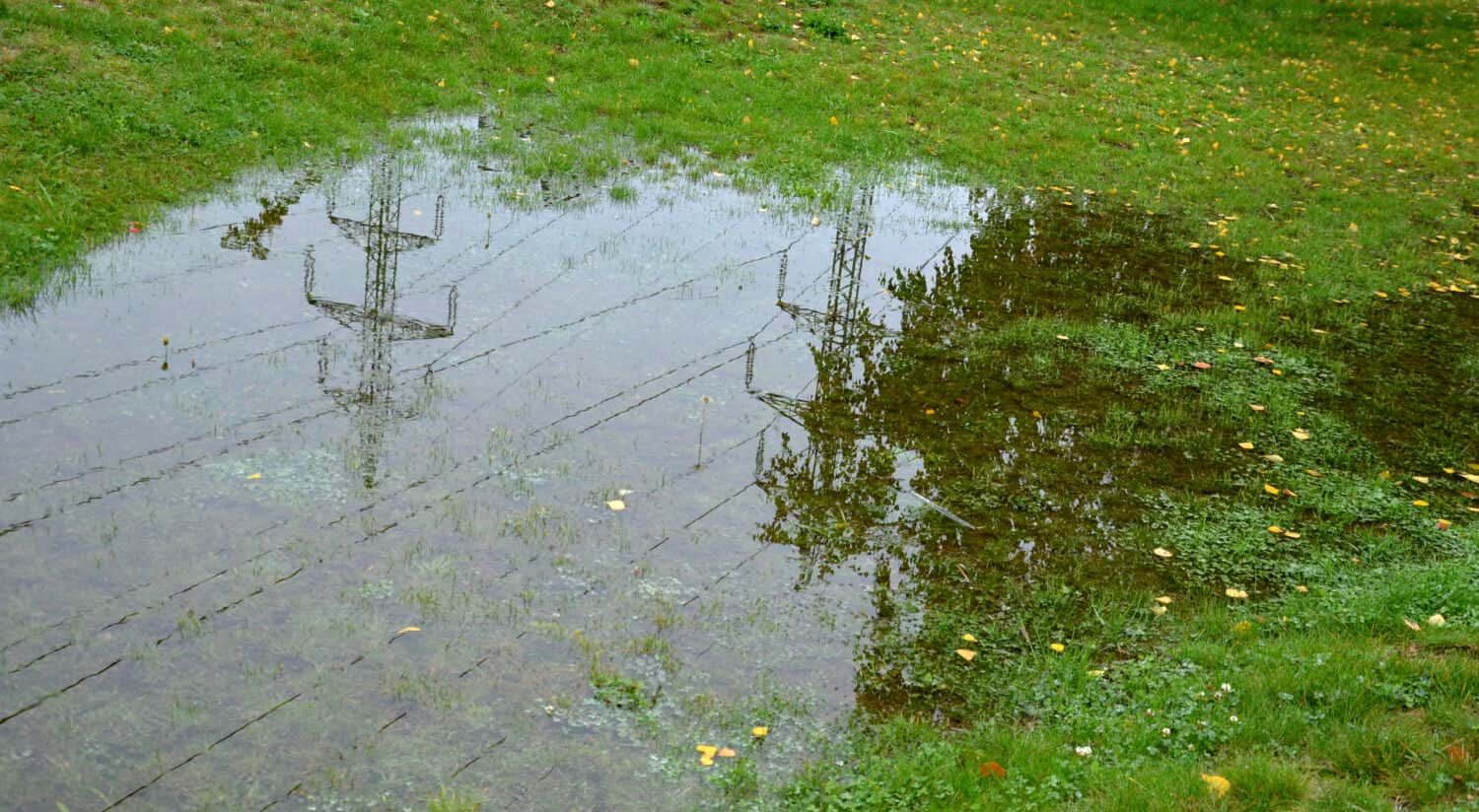
Compacted soil leads to drainage issues.
©Beekeepx/Shutterstock.com
Soil Compaction
Compacted soil is a common enemy of healthy zoysia grass. When your soil becomes compacted, it restricts root growth, limits water infiltration, and hinders the exchange of essential nutrients. Signs of compacted soil include poor drainage, standing water, and the difficulty of pushing a garden fork or soil probe into the ground. Aerating your soil by perforating it with small holes alleviates compaction and promotes better root development.
Drainage Issues
Poor drainage can lead to waterlogged soil, suffocating your lawn’s roots. Ensure that your lawn has proper drainage by addressing low spots or creating slopes that allow water to flow away from the lawn. Installing drainage systems like French drains may be necessary in severe cases.
By addressing soil quality issues, you will create an optimal environment for your zoysia grass to flourish. Soil improvements not only promote healthier grass but also reduce the risk of common lawn problems.
3. Thatch Buildup
Beneath the surface of your zoysia grass lies a potential hindrance to its health and vitality — thatch. Thatch is an accumulation of dead grass, roots, and organic debris that creates a barrier, preventing water, nutrients, and air from reaching your soil. While some thatch is natural and beneficial, excessive buildup can suffocate your zoysia grass, leading to a range of issues. Common causes of thatch buildup include:
- Grass clippings: Zoysia grass clippings and organic debris may accumulate faster than they decompose, contributing to thatch.
- Fertilizers: Excessive use of nitrogen-rich fertilizers can stimulate rapid grass growth and thatch accumulation.
- Improper mowing: Mowing too infrequently or leaving grass clippings on your lawn can add to thatch buildup.
- High Soil pH: Alkaline soil conditions can hinder the breakdown of organic matter and promote accumulation.
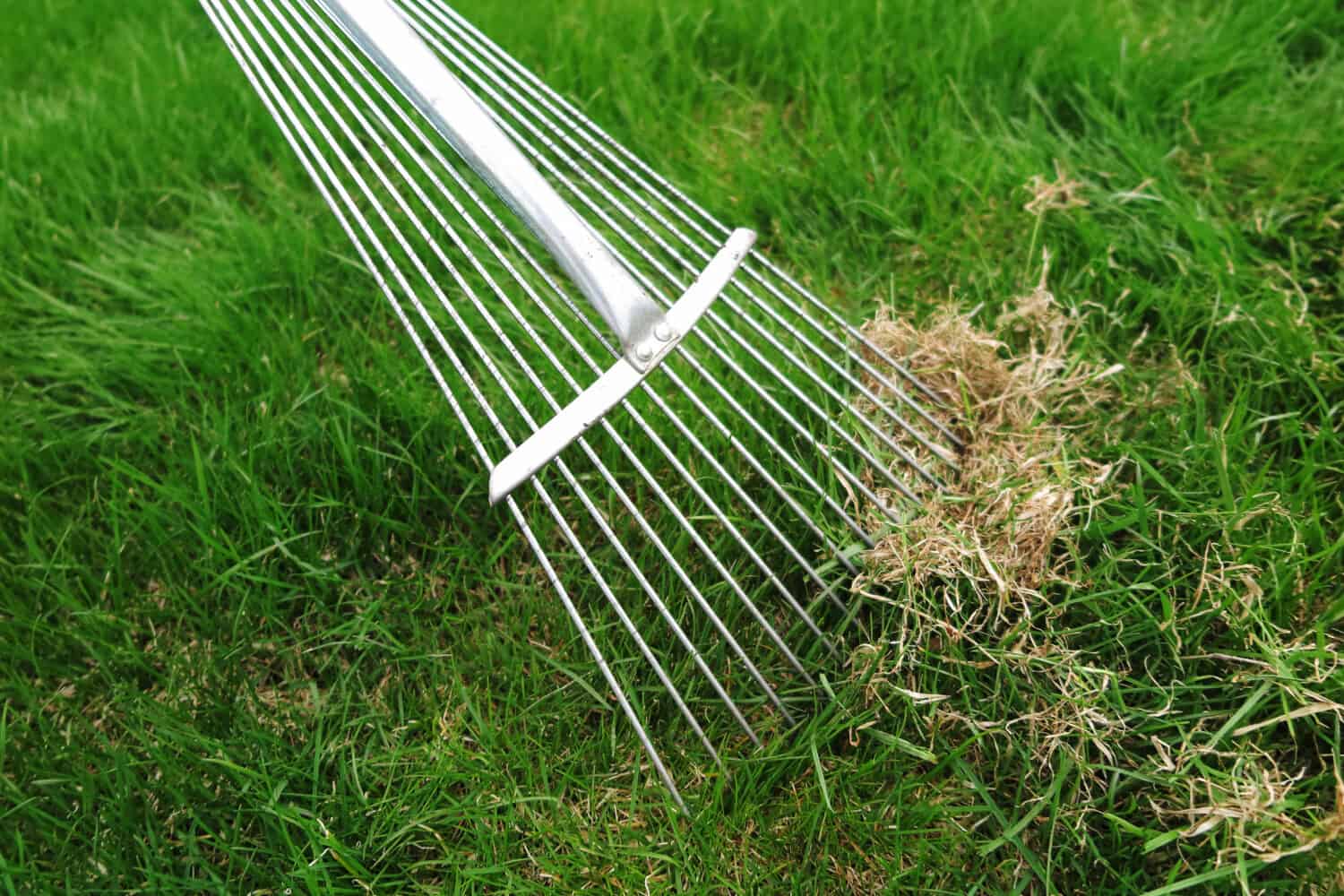
Zoysia grass has a dense growth habit that results in excessive thatch.
©photowind/Shutterstock.com
Signs of Excessive Thatch
It is important to recognize the telltale signs of excessive thatch accumulation to ensure your zoysia grass remains a thick, green carpet.
- Spongy texture: Walking on your lawn feels soft and spongy.
- Reduced water infiltration: Water puddles on your lawn’s surface instead of soaking in.
- Dull appearance: Your zoysia grass may appear stressed, with yellowing or thinning areas.
- Increased pests and disease: Thatch provides a favorable environment for pests and diseases to thrive.
Thatch Management
Aeration and dethatching prevent soil compaction and are part of good thatch management practices. Some soils are dense, compact, and nutrientless. Aeration involves perforating the soil with small holes to allow air, water, and nutrients to reach your grass root zone.
There are two types of common aeration: core aeration and spike aeration. Aerate your zoysia grass lawn in late spring to early summer if you notice compacted soil.
Furthermore, dethatching removes accumulated dead grass and debris from your lawn. Aim to remove your thatch when the layer becomes one-half inch thick or more using a dethatching machine or a dethatching rake.
4. Inadequate Fertilization
Never underestimate the significance of proper lawn nutrition. Inadequate fertilization contributes to the decline of your lawn’s health and aesthetics. Zoysia grass exhibits signs of distress from inadequate fertilization, including stunted growth, pale coloration, thinning, and increased weeds.

Zoysia grass growing in sandy soils needs extra potassium.
©iStock.com/
Correcting Inadequate Fertilization
pH measures acidity and alkalinity. It has a significant impact on the health of turfgrasses like zoysia grass. Zoysia grass prefers a slightly acidic to neutral pH range of around 6.0 to 7.0. Soils that are too acidic, low pH, or too alkaline, high pH, can limit nutrient availability and affect the color and growth of your lawn.
A thriving zoysia grass lawn begins with proper soil preparation. Experts recommend conducting a soil test annually to determine your soil’s pH and nutrient levels. Afterward, add soil amendments as needed to promote growth.
Organic material such as compost enhances soil quality by improving its structure, drainage capacity, and ability to retain essential nutrients. Typically, fertilizers consist of three primary components: nitrogen (N), phosphorus (P), and potassium (K), each represented by a number on the label. For instance, a fertilizer labeled as 5-15-10 contains 5% nitrogen, 15% phosphorus, and 10% potassium. When choosing a fertilizer, match the nutrient ratio to the recommendations based on your soil test results to effectively nourish your lawn or garden.
Zoysia grass commonly lacks nitrogen more than phosphorus or potassium. It is also the nutrient associated with promoting lush, green growth.
5. Improper Mowing
Mowing your zoysia grass lawn may seem like a straightforward task, but the way you approach mowing significantly impacts your lawn’s health and appearance. Improper mowing practices can lead to a host of issues, from scalped grass and weakened roots to an overall diminished aesthetic.
Zoysia grass’ fine texture and unique growth habits require specific care to remain lush and resilient. Common signs of improper mowing techniques include:
- Scalped grass: Cutting your grass too short results in scalping, where the mower blade cuts into the grass crowns, leading to brown patches and potential damage.
- Uneven grass blades: Mowing with dull blades tears grass rather than cleanly cutting the blades, leaving an uneven and ragged appearance.
- Weakened roots: Frequent, shallow mowing results in shallow root systems, making your grass more susceptible to drought stress.
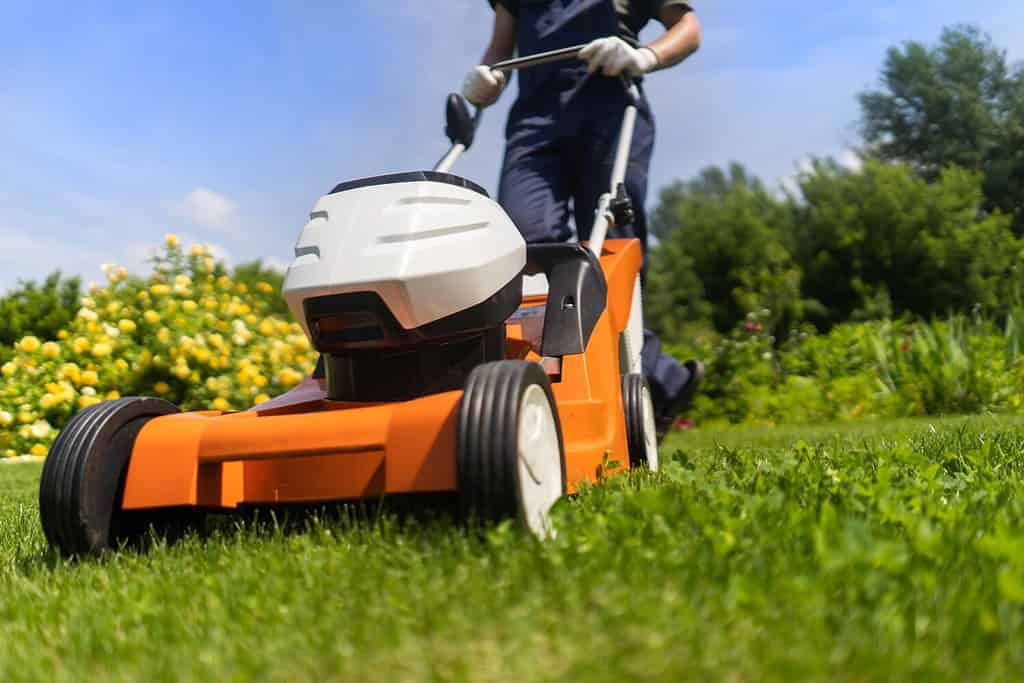
Mow zoysia as low as possible, but avoid scalping.
©africa_pink/Shutterstock.com
Proper Mowing Techniques
Proper mowing practices ensure that your lawn maintains its rich green color, lush density, and vitality. Avoid the pitfalls of improper mowing by following a few simple steps:
- Height: Zoysia grass thrives when mowed at a recommended height of 1 to 2 inches. However, different varieties may have specific height preferences, so check your variety’s requirements.
- Sharpen mower blades: Ensure your mower blades are sharp to achieve clean cuts and avoid shredding your grass. Experts recommend sharpening your mower blades annually before the spring growing season.
- Regular maintenance: Follow a regular mowing schedule that removes no more than one-third of your grass height in a single mowing session. Additionally, adjust your mower to avoid scalping. Zoysia grass grows more slowly than other grass varieties, which means you may mow less frequently.
- Mulch grass clippings: Mulch your grass clippings when mowing to return nutrients to the soil and enhance moisture retention.
6. Invasive Weeds
Unfortunately, pesky weeds can overrun even the most well-kept lawn. These unwelcome guests compete for resources, disrupt the uniformity of your lawn, and diminish its overall appeal. Invasive weeds are not just an eyesore; they can also weaken the health of your zoysia grass. Common weeds affecting zoysia grass cultivars include:
- Crabgrass: This common annual weed has a grass-like appearance. It spreads rapidly, choking out zoysia grass. Treat crabgrass with proper lawn maintenance and post-emergent herbicide designed for crabgrass.
- Dandelion: These common broadleaf weeds produce deep taproots, making them challenging to extinguish. They have a distinct appearance with bright yellow flowers that turn into white, airy puffballs. Treat broadleaf weeds with a targeted broadleaf herbicide or by hand pulling.
- Clover: Clover competes with zoysia grass for nutrients and can take hold in thinner areas of your lawn. It has distinct trifoliate leaves and a creeping growth habit. Treat clover by mowing and applying herbicides.
- Chickweed: This low-growing weed forms dense mats in your lawn, smothering your grass. It has a spreading growth habit like clover. Treat chickweed by hand pulling, mowing, or applying pre-emergent herbicide in the spring and fall.

Crabgrass is one of the most pervasive weeds in zoysia grass.
©iStock.com/Yesim Sahin
Weed Management
Weed management is a comprehensive process essential to maintaining a healthy and attractive zoysia grass lawn. More importantly, effective weed management involves a combination of preventive measures and control methods, including:
- Routine maintenance: Maintain a healthy zoysia grass lawn through proper watering, fertilization, and mowing practices to prevent weed infestations.
- Herbicides: Selective herbicides designed for use with zoysia grass target specific weeds. Additionally, post-emergent herbicides control and eliminate weeds that have already germinated, while pre-emergent herbicides prevent weed seeds from germinating and establishing themselves in your soil.
- Manual removal: Hand-pull or dig out individual weeds with a dandelion fork, ensuring you remove the entire root system. This method is effective against broadleaf weeds with deep taproots.
- Lay mulch: Apply mulch to your garden beds and borders to prevent weed growth from spreading to your lawn.
- Overseeding: Overseeding can help thicken your zoysia grass, making it more competitive against weeds.
- Professional help: If weed infestations are severe or persistent, consider consulting with a lawn care professional for targeted solutions.
7. Disease Infestations
Disease infestations can pose a threat to the health and appearance of your zoysia grass lawn. Several fungal diseases can affect zoysia grass, causing issues such as brown patches, yellowing, thinning, and overall deterioration. Common diseases include:
- Large patch: Large patch is a fungal disease that causes circular or irregularly shaped patches of discolored and thinning grass. Treat large patch with fungicide applications and proper irrigation management.
- Brown patch: Brown patch is another fungal disease that affects zoysia grass in warm, humid weather. It causes circular or irregular patches of brown, with green grass in the center. The affected grass blades may have a dark brown margin. Treat brown patch with fungicide applications and proper water management techniques.
- Dollar spot: Fungal dollar spot causes small, circular, straw-colored spots on your grass blades, resembling silver dollars. Similar to other fungal diseases, treat dollar spot with fungicide and proper fertilization.
- Rust: Rust fungus manifests as orange to reddish-brown pustules on your grass blades. It gives your grass a rusty-orange appearance and weakens the overall health of your lawn. Apply fungicide applications and maintain your lawn with proper techniques to treat rust.
- Fairy ring: Fairy ring is a complex type of fungi that causes circular or arc-shaped rings of dark green, fast-growing grass. Stunted or discolored grass often surrounds the rings. Aerate your soil and apply fungicide to control the fairy ring.

Fungal diseases often affect zoysia cultivars.
©SingjaiStocker/Shutterstock.com
Disease Management
Like weed management, effective disease management also involves a combination of preventive measures and treatments. Follow these simple steps to manage disease infestations in your zoysia grass:
- Routine maintenance: A healthy zoysia grass lawn is less susceptible to diseases. To maintain lawn vigor, implement proper lawn care practices, including regular watering, fertilization, and mowing.
- Reduce humidity: Excessive moisture and humidity encourage disease development. Water your lawn in the morning to allow sufficient time for grass blades to dry during the day and avoid overwatering.
- Avoid excessive nitrogen: High levels of nitrogen fertilization can make zoysia grass more susceptible to certain diseases. Use balanced fertilizers and follow recommended application rates.
- Dethatching: Regular dethatching can help reduce conditions conducive to disease development by improving air circulation and water penetration.
- Aeration: Core aeration improves soil drainage and reduces compaction, which can contribute to disease prevention.
- Fungicide applications: Apply fungicides specifically designed to target identified diseases.
- Reseed: For localized disease damage, reseed affected areas to promote recovery.
- Remove grass clippings: Remove diseased grass clippings and debris from your lawn to prevent the spread of fungal spores.
8. Pest Invasions
Pest invasions also threaten the health and vitality of your zoysia grass lawn. Insects and other pests cause various types of damage, from chewing on grass blades to tunneling in your soil. Common pests found in zoysia grass include:
- Chinch bugs: One of the most prolific zoysia grass pests, chinch bugs are tiny insects that feed on the sap of your grass blades. They can cause yellowing and drying of grass, often leading to dead patches. Apply a selective insecticide to treat the invaders.
- Armyworms: These striped caterpillar larvae quickly defoliate your zoysia grass by chewing on your grass blades. Spot-treat infected areas with a selective insecticide.
- White grubs: White grubs are also a larval species. These beetle larvae feed on the roots of your zoysia grass, which results in brown, dead patches in your lawn. Spread a grub control product across infected areas and water your lawn after the application.
- Sod webworms: This pest is also a caterpillar. Sod webworms feed on zoysia grass leaves, leaving behind brown and irregularly shaped patches of damaged grass. Treat the nuisances with a selective insecticide.
- Mole crickets: Mole crickets are burrowing insects that tunnel through the soil, damaging the roots of your zoysia grass. Additionally, their tunnels disrupt the stability of your lawn. Treat with a selective insecticide.
- Nematodes: These microscopic roundworms are pervasive in the Southeast, including states like Florida, Louisiana, and Mississippi. They damage your zoysia’s roots, leading to reduced water and nutrient uptake. Nematode control is a complex process best left to the professionals.
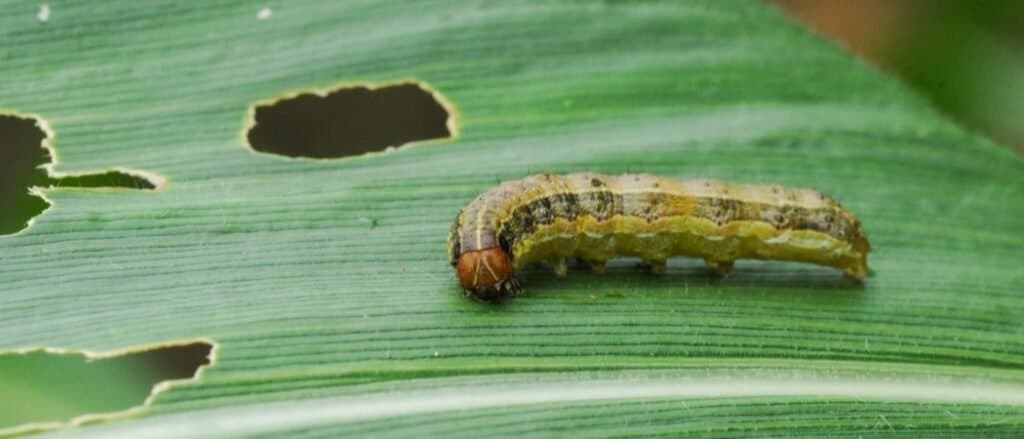
Armyworms are one of the most common lawn pests invading zoysiagrass in the fall.
©kale kkm/Shutterstock.com
Preventative Pest Management
Effective pest management requires a combination approach tailored to the specific pests you encounter. First, a well-maintained zoysia grass lawn is your best defense against pests. Always practice mindful irrigation and keep your thatch layer under one-half inch.
More importantly, if you identify a pest in your landscape, remove the culprit as soon as possible. Insecticidal soaps or horticultural oils effectively control certain pests without harming beneficial pollinators and other insects. However, for stubborn infestations, targeted insecticides or professional help are more effective.
Pest management is not a one-size-fits-all solution. Rather, it is an ongoing process that begins with preventative maintenance.
9. Extreme Weather
Extreme weather poses significant challenges to the health and maintenance of your zoysia grass lawn. From scorching heat waves to severe droughts or intense cold snaps, your lawn can be susceptible to stress, damage, and even death when exposed to extreme conditions.
Thankfully, zoysia grass is drought-tolerant. However, during heatwaves and dry spells, water your lawn deeply and infrequently to encourage deep root growth and drought resistance. Additionally, raise your mower blade to a higher setting. Longer grass blades provide shade to your soil and reduce water evaporation.
While zoysia grass is a warm-season grass type, some southern states still experience cold snaps, frost, and even snow. Never walk on frozen or frost-covered grass. Furthermore, consider applying a winterizing fertilizer in the late fall to strengthen your zoysia grass lawn for the winter months.
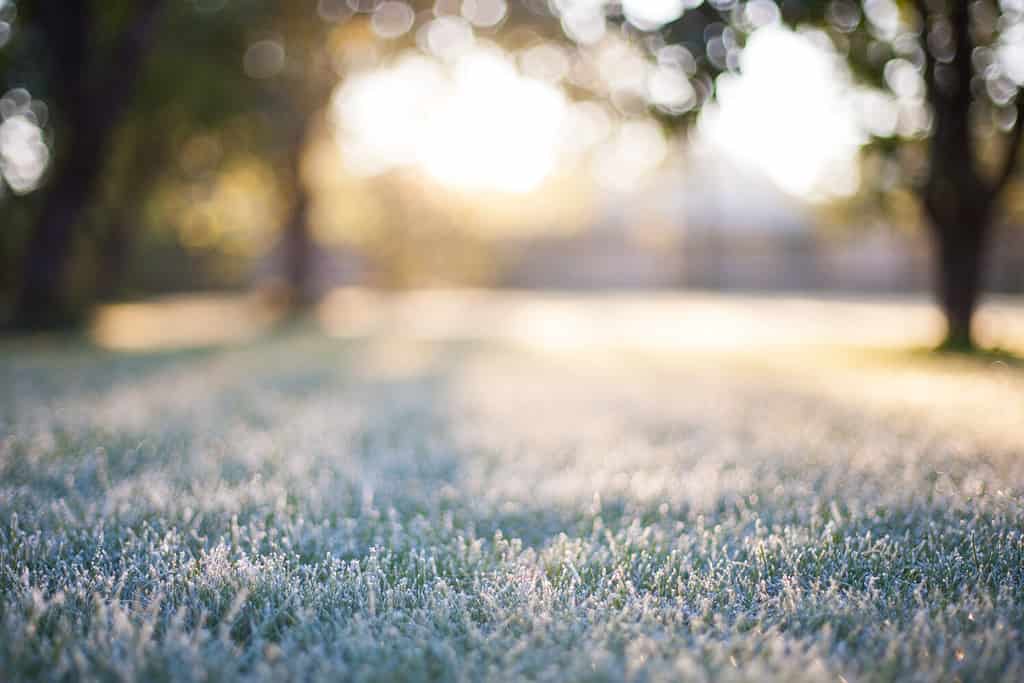
Zoysia grass turns brown with the first fall frost.
©Evoque Arte/Shutterstock.com
10. Insufficient Aeration
Adequate aeration is a critical aspect of maintaining your zoysia grass lawn. Without proper aeration, your lawn can suffer from compaction, reduced root growth, and poor air and water infiltration.
Aeration is the process of perforating your soil with small holes to alleviate compaction and promote healthy grass growth. It allows air, water, and nutrients to penetrate the soil and reach your lawn’s root zone. Zoysia grass lawns benefit significantly from regular aeration. Experts recommend aerating your lawn once a year, preferably during the growing season. Watch for the following telltale signs your zoysia grass is ready for aerating:
- Pooling water: Water puddles left on your lawn’s surface after rainfall or irrigation indicates poor water infiltration.
- Thatch buildup: Excessive thatch buildup, over one-half inch, suffocates your soil leading to compaction.
- Sparse growth: Areas with thin or sparse grass growth, especially in high-traffic areas, indicate compacted soil.
- Dull color: A dull or faded color can signal nutrient deficiencies caused by limited root access to vital resources.
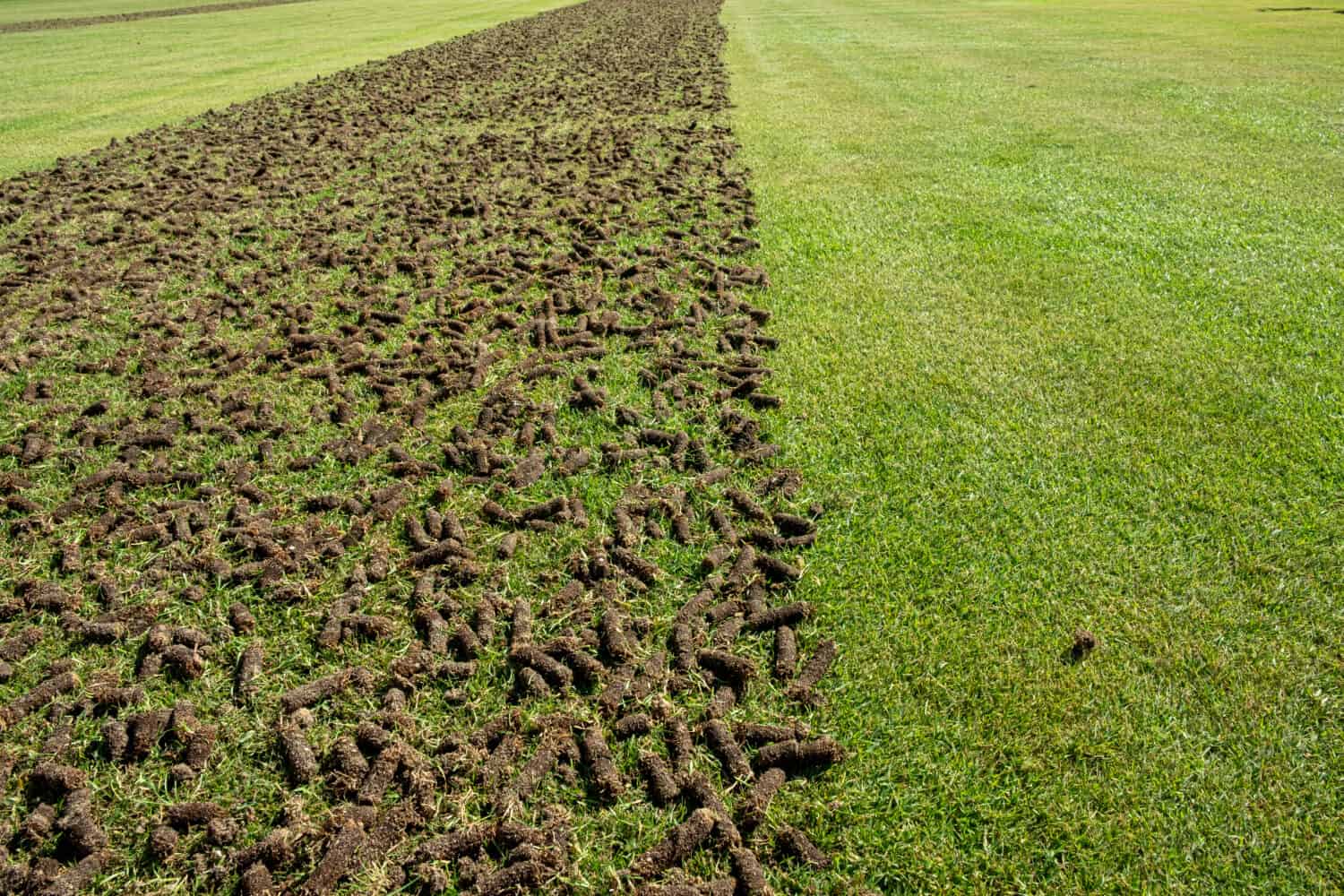
The best time to aerate zoysia grass is in the early summer.
©Oldboys/Shutterstock.com
Addressing Insufficient Aeration
Promote a healthier lawn by aerating your turfgrass. Core aeration is the most common method for relieving soil compaction. This process involves the removal of small soil plugs from your lawn, creating channels for air, water, and nutrients to penetrate the soil.
Rent or purchase a core aerator or consider hiring a lawn care professional to perform the task. Aerate your lawn during the growing season when your grass can quickly recover, typically in the late spring or early fall. Additionally, ensure your soil is slightly moist but not overly saturated for effective aeration.
Run the aerator over your lawn in a grid-like pattern, allowing for overlapping passes to ensure thorough coverage. Lastly, leave the soil cores on your lawn’s surface; they will break down naturally over time, contributing organic matter to your soil.
By addressing insufficient aeration and maintaining a proper aeration schedule, you can significantly improve the health and vitality of your zoysia grass lawn, ensuring it remains lush and resilient year after year.
Nurturing Your Zoysia Grass Lawn to Last
From addressing issues like insufficient aeration to mastering proper watering, fertilization, and pest management knowledge, knowledge and routine maintenance are the building blocks of a thriving home lawn. Remember, aeration is the foundation that helps build your lawn’s health and resilience. However, your commitment to year-round maintenance ensures that your zoysia grass remains a thick, lush carpet for years to come.
Summary: 10 Reasons Your Zoysia Grass Keeps Dying
| Number | Reasons Your Zoysia Grass is Dying |
|---|---|
| 1 | Improper watering |
| 2 | Poor soil management |
| 3 | Thatch buildup |
| 4 | Inadequate fertilization |
| 5 | Invasive weeds |
| 6 | Improper mowing |
| 7 | Disease infestations |
| 8 | Pest invasions |
| 9 | Extreme weather |
| 10 | Insufficient aeration |
Thank you for reading! Have some feedback for us? Contact the AZ Animals editorial team.

